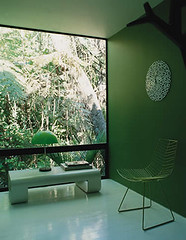 Image by coco+kelley via FlickrBy John Goodden
Image by coco+kelley via FlickrBy John GooddenGreen interior design is radically different to interior design because it is based on a completely different set of criteria. The main thrust of green interior design is to help the environment and to improve indoor air quality.
To better understand how green interior design seeks to address these challenges it is necessary to look at the guidelines laid out under the Leadership in Energy and Environmental Design (LEED) organization which was set up by the US Green Build Council in 1998.
LEED identify 5 key metrics which green interior design should address. These metrics are reducing carbon emissions, conserving water, improving energy efficiency, improving indoor air quality and better husbanding of natural resources. Nowhere in the metrics is there mention of fashion or the need for wall hangings or oriental soft furnishings. Of course a home can be environmentally friendly and have a cutting edge minimal look or pleasing rustic look.
The point is that green interior design is based on how it benefits the environment and keeps people healthy not on any changeable notion of 'style' or 'coolness' or 'elegance'. Statistics are the indicators of success or failure not the aesthetic sensibilities of the homeowner.
It is important to look at how a house can improve its insulation to help reduce heating and cooling bills and thus lower carbon emissions. To make a house more environmentally friendly it is a good idea to consider installing programmable thermostats, compact fluorescent light bulbs, energy saving power strips and energy efficient home appliances among many other possible actions to lower energy consumption. This is great for the home owner because it means lower bills to pay every month.
Another area that is of the utmost importance to green interior design is water conservation. Actions like installing low flow showerheads and faucet aerators and collecting rainwater to water the garden are good examples of how water can be conserved.
The metric concerned with reducing carbon emissions is very much connected to power consumption. For those people not buying 'green' electricity, every kilowatt-hour of electricity consumed means so much carbon emitted by a power station. As well as lower electricity consumption green interior design is keenly interested with alternative and cleaner sources of energy such as solar power.
People's health is of primary concern to green interior design. People in the developed world spend 90% of their lives indoors so good indoor air quality is vital. One of the key issues is with volatile organic compounds that off-gas easily and cause respiratory problems, cancer and other serious medical conditions. The best way to avoid VOCs is to check flooring, furniture, office and household products for their VOC content and try to replace the worst offenders with healthier alternatives.
Finally there is the issue of natural resource management. This is about switching from using quickly depleting resources like hardwood and using renewable resources instead such as bamboo, jute, coconut, cork, hemp and water hyacinth. Another strategy is sourcing furniture etc. that is produced by companies committed to sustainable management of resources. There is also concern with looking at the lifespan of a product and the impact it has on the environment in terms of pollution. Obviously recycling and upcycling feature heavily in the ethos of green interior design.
There is so much that can be done for most homes and offices to make them earth friendly and the great thing is that these actions also often result in the lowering of bills. Saving money, being healthier indoors and helping to improve the future are the noble ideals of a discipline that will surely be of more interest to the general public as the recession deepens and environmental health worsens.
Read more about the ethos behind green interior design and what you can do to green up your home.
Article Source: http://EzineArticles.com/?expert=John_Goodden
http://EzineArticles.com/?The-Idea-Behind-Green-Interior-Design&id=5580113

No comments:
Post a Comment